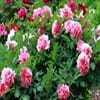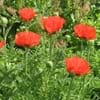Life Span
Perennial
Perennial
Type
Flowering Plants, Herbaceous Perennial
Flowering Plants, Fruits, Trees
Origin
Asia
Central America, Europe, North America
Types
Bowl of Beauty, Laura Dessert
Not Available
Habitat
Dappled Shade, Woodland Garden
Hedge, Scrubs, Woods
USDA Hardiness Zone
4-8
4-8
AHS Heat Zone
8-1
Not Available
Sunset Zone
A3, 1a, 1b, 2a, 2b, 3a, 3b, 4, 5, 6, 7, 8, 9, 10, 11, 12, 13, 14, 15, 16, 17, 18, 19, 20, 22
Not Available
Habit
Clump-Forming
Not Available
Flower Color
White, Light Pink
White
Flower Color Modifier
Bicolor
Not Available
Fruit Color
Not Available
Yellow
Leaf Color in Spring
Red, Dark Green, Bronze
Dark Green
Leaf Color in Summer
Green, Dark Green
Green
Leaf Color in Fall
Green, Dark Green, Bronze
Brown, Green, Light Yellow
Leaf Color in Winter
Not Available
Not Available
Leaf Shape
Lance shaped
Oblong
Plant Season
Spring, Summer
Summer
Sunlight
Full Sun, Partial Sun
Full Sun, Partial shade
Type of Soil
Clay, Loam, Sand
Loamy
The pH of Soil
Acidic, Neutral, Alkaline
Neutral
Soil Drainage
Well drained
Well drained
Bloom Time
Late Spring, Early Summer
Fall, Summer
Tolerances
Not Available
Drought
Where to Plant?
Ground
Ground
How to Plant?
Root Division, Seedlings
Grafting, Seedlings, Transplanting
Plant Maintenance
Medium
Medium
Watering Requirements
Allow soil to be completely dry in between waterings, Water Deeply
Medium
In Summer
Lots of watering
Lots of watering
In Spring
Moderate
Moderate
In Winter
Average Water
Average Water
Soil pH
Acidic, Neutral, Alkaline
Neutral
Soil Type
Clay, Loam, Sand
Loamy
Soil Drainage Capacity
Well drained
Well drained
Sun Exposure
Full Sun, Partial Sun
Full Sun, Partial shade
Pruning
Remove damaged leaves, Remove dead branches, Remove dead leaves
Prune when plant is dormant, Remove dead or diseased plant parts
Fertilizers
5-10-10 fertilizer
All-Purpose Liquid Fertilizer
Pests and Diseases
Leaf Blotch, Ringspot virus, Stem rot, Tip blight, Verticillium Wilt
Aphids, Curculio occidentis, Japanese Beetles, Leaf Rollers, Leafminer, Mites, Red blotch, sawflies, Scale, Stink bugs
Plant Tolerance
Drought
Drought
Flower Petal Number
Double
Single
Foliage Texture
Coarse
Medium
Foliage Sheen
Glossy
Matte
Attracts
Ants, Butterflies, Not Available
Not Available
Allergy
no allergic reactions
Digestive Problems, Respiratory problems
Aesthetic Uses
Cut Flowers, Showy Purposes
Showy Purposes
Beauty Benefits
Not Available
Beautiful Skin
Environmental Uses
Air purification
Food for birds
Medicinal Uses
Alterative, Analgesic, Anodyne, anti inflammatory, Antibacterial, Antiseptic, Hypotensive, Tonic
Anthelmintic, Antibacterial, Astringent, Hypnotic, Laxative, Refrigerant
Part of Plant Used
Root, Seeds, Stem
Fruits
Other Uses
Eaten in a broth, Powdered and mixed with tea
Edible syrup, Jam, Jelly, Used As Food
Used As Indoor Plant
Yes
No
Used As Outdoor Plant
Yes
Yes
Garden Design
Cutflower, Feature Plant, Foundation, Mixed Border
Not Available
Botanical Name
PAEONIA lactiflora 'Shirley Temple'
Malus sylvestris
Common Name
Double Pink Peony, Garden Peony
European crab apple
In Hindi
Double Pink Peony
european crab apple
In German
Doppelte rosa Pfingstrosen
Der Holzapfel, Europäischer Wildapfel
In French
Double Rose pivoine
Le Boquettier, le Pommier sauvage ou Pommier des bois
In Spanish
Doble Pink Peony
Malus sylvestris, el Manzano silvestre, manzano silvestre europeo
In Greek
Διπλό Ροζ Παιωνία
Ευρωπαϊκή μήλο καβουριών
In Portuguese
Duplo Pink Peony
Malus sylvestris
In Polish
Podwójne Pink Peony
Jabłoń dzika
In Latin
Geminus Pink AGLAOPHOTIS
european crab apple
Phylum
Magnoliophyta
Magnoliophyta
Class
Magnoliopsida
Magnoliopsida
Order
Dilleniales
Rosales
Family
Paeoniaceae
Rosaceae
Clade
Angiosperms, Core eudicots, Eudicots
Angiosperms, Eudicots, Rosids
Tribe
Not Available
Not Available
Subfamily
Not Available
Not Available
Number of Species
Not Available
Not Available
Season and Care of Double Pink Peony and European Crab Apple
Season and care of Double Pink Peony and European Crab Apple is important to know. While considering everything about Double Pink Peony and European Crab Apple Care, growing season is an essential factor. Double Pink Peony season is Spring and Summer and European Crab Apple season is Spring and Summer. The type of soil for Double Pink Peony is Clay, Loam, Sand and for European Crab Apple is Loamy while the PH of soil for Double Pink Peony is Acidic, Neutral, Alkaline and for European Crab Apple is Neutral.
Double Pink Peony and European Crab Apple Physical Information
Double Pink Peony and European Crab Apple physical information is very important for comparison. Double Pink Peony height is 90.00 cm and width 90.00 cm whereas European Crab Apple height is 25.00 cm and width 20.00 cm. The color specification of Double Pink Peony and European Crab Apple are as follows:
Double Pink Peony flower color: White and Light Pink
Double Pink Peony leaf color: Red, Dark Green and Bronze
European Crab Apple flower color: White
- European Crab Apple leaf color: Dark Green
Care of Double Pink Peony and European Crab Apple
Care of Double Pink Peony and European Crab Apple include pruning, fertilizers, watering etc. Double Pink Peony pruning is done Remove damaged leaves, Remove dead branches and Remove dead leaves and European Crab Apple pruning is done Prune when plant is dormant and Remove dead or diseased plant parts. In summer Double Pink Peony needs Lots of watering and in winter, it needs Average Water. Whereas, in summer European Crab Apple needs Lots of watering and in winter, it needs Average Water.





